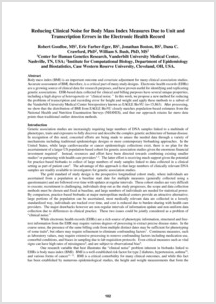Goodloe R, Farber-Eger E, Boston J, Crawford DC, Bush WS,.
Body mass index (BMI) is an important outcome and covariate adjustment for many clinical association studies. Accurate assessment of BMI, therefore, is a critical part of many study designs. Electronic health records (EHRs) are a growing source of clinical data for research purposes, and have proven useful for identifying and replicating genetic associations. EHR-based data collected for clinical and billing purposes have several unique properties, including a high degree of heterogeneity or “clinical noise.” In this work, we propose a new method for reducing the problems of transcription and recording error for height and weight and apply these methods to a subset of the Vanderbilt University Medical Center biorepository known as EAGLE BioVU (n15,863). After processing, we show that the distribution of BMI from EAGLE BioVU closely matches population-based estimates from the National Health and Nutrition Examination Surveys (NHANES), and that our approach retains far more data points than traditional outlier detection methods.

